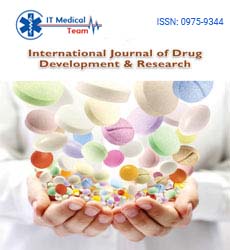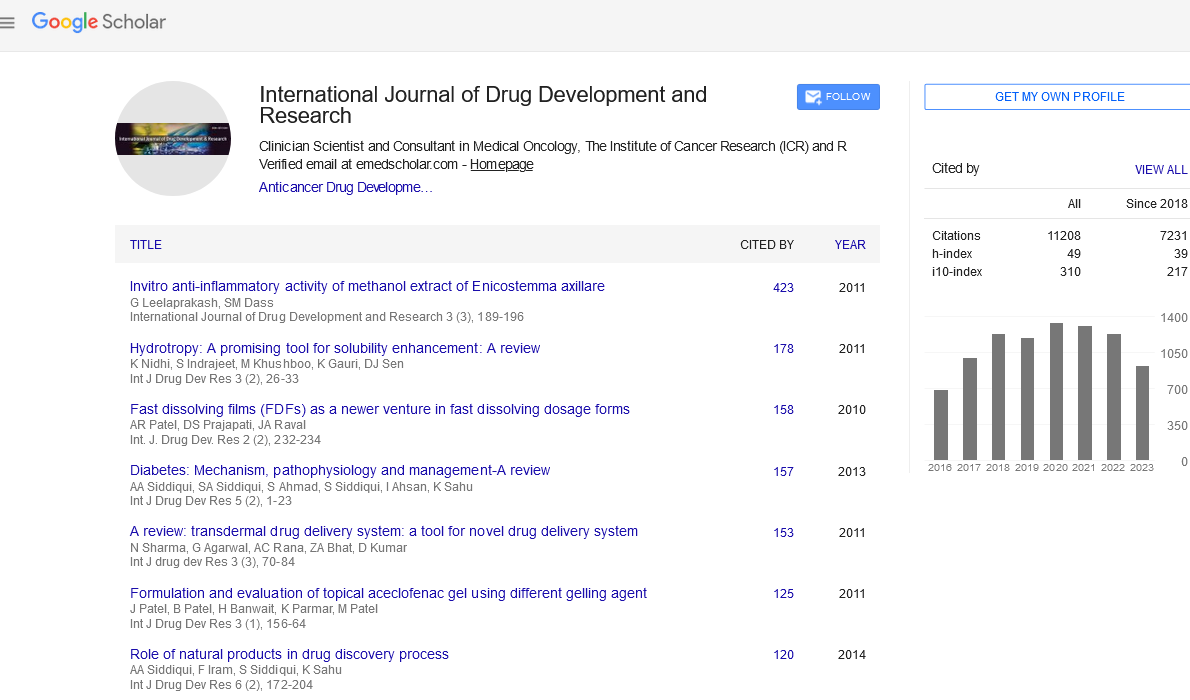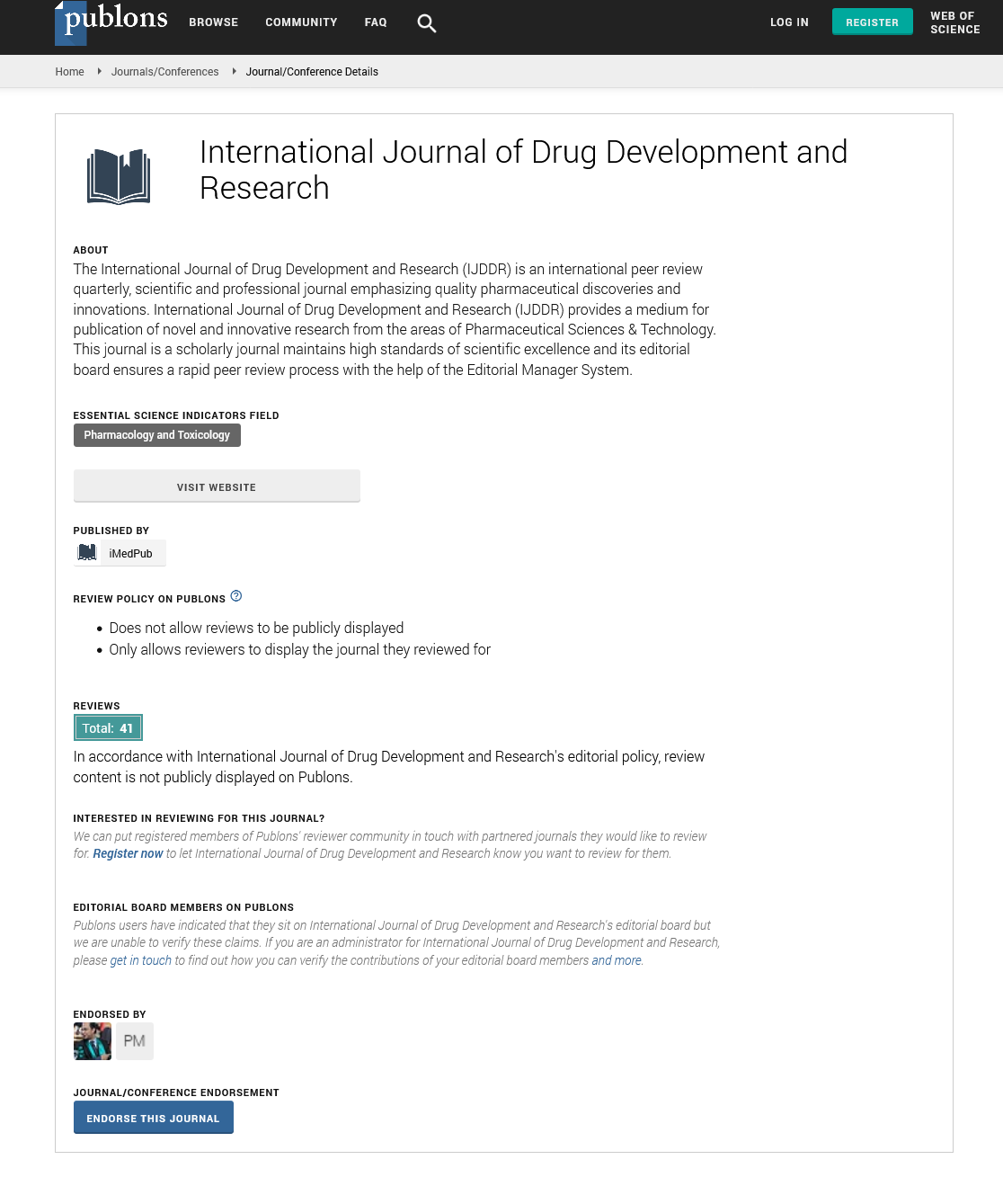Keywords
|
| Acorus calamus, scavenging activity. |
INTRODUCTION
|
| Nearly 80%of the world’s population in developing countries mainly depends on natural products for their health needs [1]. Plants are rich in secondary metabolites having curative nature. In India, nearly 7500 species are being used traditionally for the treatment of various ailments [2]. There is increasing evidence that reactive oxygen species (ROS) produced in the body may cause oxidative damages related with many degenerative diseases such as atherosclerosis, coronary heart disease and cancer. Knowledge of such potential antioxidant activities in reducing oxidative stresses has made many investigators to search for potent and cost-effective antioxidants from various plant sources [3]. Phenolic compounds present in the plants are a well-known for their ability of scavenging free radical which shows antioxidant activity [4]. Acorus calamus, commonly called as sweet flag belongs to the family acoraceae is commonly found in India. The rhizome of calamus is used for various medicinal purpose mainly appetite, fever, stomach cramps, tooth ache and cholic [5]. It is used in the conditions of hoarseness, flatulence dyspepsia, helminthiasis and nephropathy [6]. The present aim of this study is to investigate the phytochemical and In -vitro antioxidant activity of the rhizome of Acorus calamus. |
MATERIALS AND METHODS:
|
|
Sample collection
|
| Fresh rhizomes of Acorus calamus were collected from the Karaikudi village, Tamilnadu, India. Then, they were washed throughly with distilled water to remove the dust particles present in it, shade dried and grounded into fine powder using mechanical grinder and stored in the airtight container for further use. |
|
Sample extraction
|
| 100 g of Acorus calamus rhizome powder was extracted with 500 mL ethyl acetate in a soxhlet extractor for 5 hours and the extraction was repeated thrice. The collected filtrate was filtered using Whatmann filter paper No.1 and condensed using rotary vacuum evaporator and stored in the refrigerator for further use [7] |
|
Phytochemical analysis
|
| The phytochemicals such as Phenolics, flavonoids, alkaloids, carbohydrates, proteins, tannins and terpenoids present in the extracts were carried out by following the standard procedure of Trease and Evans [8]. |
|
Total phenolic content
|
| Total phenolics present in the extract were evaluated using Folin’s ciocalteau method previously described by Gao et al., with little modifications [9]. 1 ml of the rhizome extract were mixed with 2 ml of Folin’s ciocalteau (1:1) reagent and incubated at room temperature for 5 min. 1ml of 20% sodium carbonate was added to the mixture and incubated for 1 hr at room temperature. Absorbance of the mixture was measured at 765 nm using UV spectrophotometer. Gallic acid (GAE) was used to calibrate the standard curve. The experiments were done in triplicates and the results were expressed as mg/g of GAE equivalent. |
|
Total Flavonoid content
|
| Total flavonoid present in the extract was determined by the Aluminium chloride method of Brighente et al., with slight modifications [10]. 1 ml of rhizome extract was mixed with equal volume of 2% Aluminium chloride and incubated at room temperature for 15 min. Absorbance of the mixture was measured at 430nm in UV spectrophotometer against the blank. Quercetin was used to calibrate the standard curve. The experiments were done in triplicates and the results were expressed as mg/g Quercetin equivalent. |
|
Reducing power assay
|
| The reducing potential of the rhizome extract was determined by the method of Oyaizu et al., with slight modifications [11]. Different concentration of the extracts were prepared and mixed with 2.5 ml phosphate buffer and potassium ferricyanide and the mixture was kept at 50°C in water bath for 20 min. Followed by 2.5 ml of 10% trichloroacetic acid was added after cooling and centrifuged at 3000 rpm for 10 min. 2.5 ml of supernatant was mixed with 0.5 ml of ferric chloride solution and the absorbance was measured at 700 nm using UV spectrophotometer. Increasing absorbance indicates the increase in reducing power. |
|
Total antioxidant activity
|
| Total antioxidant activity of rhizome extract of A. calamus was measured according to the method of Prieto et al., [12]. 1 ml of the different concentration of the extracts were mixed with 1 ml of reaction mixture contains 0.6 M sulphuric acid, 28mM sodium phosphate and 4mM ammonium molybdate. Then, the reaction mixture was incubated at 95°C for 90 min. |
| Experiments were done in triplicates and absorbance of the reaction mixture was measured at 635 nm using UV spectrophotometer. The total antioxidant activity was calculated using the equation. |
 |
|
Free radical scavenging activity DPPH free radical scavenging activity
|
| The DPPH free radical scavenging activity of the extracts was evaluated using the method described by Bracca et al., with little modifications [13]. Different concentrations of the extracts were mixed with 3 ml of DPPH solution (0.4mM in ethanol). Then, the mixture was incubated at dark for 30 min and absorbance was measured at 517 nm using UV spectrophotometer. A reagent without the mixture used as a control. Experiments were done in triplicates and the scavenging activity against free radical was calculated using the equation as mentioned above. |
|
Superoxide anion radical scavenging activity
|
| Superoxide anion radicals scavenging activity of rhizome extracts was measured by following the method described by Liu et al., [14]. Different concentration of the extracts was prepared and mixed with 3 ml of Tris - HCl buffer (16 mM, pH 8.0) containing 1 ml of NBT (50 μM), 1 ml NADH (78 μM). 1ml of Phenanzine methosulphate (10 μM) was added to the mixture to start the reaction and incubated at 25°C for 5 min and the absorbance was read at 560nm using a UV spectrophotometer. Experiments were done in triplicates and the percentage of inhibition was calculated by following the equation as mentioned above. |
|
Hydroxyl radical scavenging activity
|
| Hydroxyl radical scavenging activity of the rhizome extracts was measured by using a deoxyribose method [15]. 0.2 ml of different concentration of extract was mixed with 0.8 ml of phosphate buffer , 0.2 mL of EDTA (1.04 mM), 0.2 mL of FeCl3 (1mM) and 0.2 mL of 2- deoxyribose (60mM). Then, the mixture was incubated at 37°C and the reaction was started by adding 0.2 ml of ascorbic acid (2 mM) and 0.2 mL of H2O2 (10 mM). After 1 hr at room temperature, 2 ml of 10% Thiobarbutyric acid was added. Then, the mixture was heated for 15 min at 100°C. After cooling, the absorbance was measured at 532nm and the percentage of scavenging activity was calculated as per the equation mentioned above. |
RESULTS
|
| The results had shown the presence of phytoconstituents such as Carbohydrates, phenolics, flavonoids, alkaloids, tannins, terpenoids and saponins as shown in the table 1. The presence of phytoconstituents which are known to exhibit medicinal as well as physiological activities. Several studies have suggested the presence of secondary metabolities to shown some biological activity in humans [15]. |
| Total phenolic content present in the extract was found to be 52.62 ± 0.32 mg/g Gallic acid equivalents. Phenolic compounds are one of their important dietary roles as antioxidants and chemo preventive agents [16] . Phenols are considered as an important constituent because of their scavenging activities because of their hydroxyl groups in the structure [17]. Phenolic compounds were associated with antioxidant activity and play an important role in scavenging free radicals has been reported [18]. Flavonoids act as potential antioxidants depend upon its molecular structure. The position of the hydroxyl groups and the other features in the structure plays a role in the antioxidant and free radical scavenging activities. The total flavonoid present in the A. calamus was found to be 54.2 ± 0.15 mg Quercetin /grams equivalents. The antioxidant activities of A. calamus extracts were measured by Phosphomolybdneum method. At 1000Bg/ml, the crude extracts exhibited maximum antioxidant activity as shown in the fig 1. Fig 2 shows the reductive potential of the crude extract of A. calamus. The reducing power of the extract might be due to their hydrogen?donating ability [19]. Increasing absorbance indicates the increasing reducing potential of the extract. |
| Plants with antioxidant activities have been reported to possess free radical scavenging activity [20]. Free radicals are known as major contributors to several clinical disorders such as diabetes mellitus, cancer, liver diseases, renal failure and degenerative diseases as a result of deficient natural antioxidant defence mechanism [21]. |
| The scavenging activity assay on DPPH of this extracts result indicates that the plants extract contain active constituents that are capable of donating hydrogen to a free radical. The radical scavenging activity of the A. calamus extract increased with increasing concentrations as depicted in the Fig 3. At 1000Bg / ml, it shows the maximum scavenging activity of 54.32 ± 1.32 %. |
| Superoxide anion radical is one of the strongest reactive oxygen species among the free radicals that are generated. The A. calamus crude extracts were investigated for the superoxide scavenging assay and the results were clearly presented in the figure 4. The percentage inhibition of superoxide generation by 1000Bg/ml was found to be 58.72 ± 1.08. |
| Hydrogen peroxide is a oxidizing agent probably reacts with Fe²+ and Cu²+ ions to form hydroxyl radicals and this may induce many toxic effects to cell [22]. A. calamus crude extract has shown as a maximum scavenging activity at 1000Bg/ml of 50.08 ± 1.31 %. Fig 5 reveals the scavenging activity on hydroxyl radical of the crude extract of A. calamus. |
DISCUSSION
|
| The antioxidant potential of several plants have been known from last century. Plants are considered as source of Reactive oxygen species inhibitors. The present studies has also shown that the Acorus calamus rhizome extract possess antioxidant activity to scavenge free radicals. Few evidences have suggested that the compounds such as phenolics, flavonoids, tannins, terpenoids present in the natural sources are being potential natural antioxidants [23]. Free radicals play a vital role in a variety of pathological conditions such as cardiovascular and neurological disorders. Antioxidant compounds have a potential to scavenge free radicals such as DPPH, superoxide and hydroperoxides thus reduces the level of oxidative stress [24]. Total phenolic content were determined by Folin’s ciocalteau reagent, flavonoid content by Aluminium chloride method, antioxidant assays includes DPPH, superoxide and hydroxyl ion scavenging assays were done in this study represents a convenient and reliable method for the determination of antioxidant potential of compounds [25]. |
| Phenolic compounds are the major constituents because of their scavenging potential due to their hydroxyl groups in the structure [26]. Flavonoids are a group of polyphenolic compounds which exhibits several biological effects such as anti-inflammatory, antiviral and anticancer activity. Phenolic compounds are associated with the antioxidant activity were reported by Cao et al [27]. The reducing potential of A. calamus is a significant indicator of antioxidant activity. The conversion of Fe3+ into Fe 2+ in the presence of antioxidants indicates the reducing power of A. calamus rhizome extract. It usually depends on the presence of reductones which exerts the activity by donating the hydrogen atom for the breakage of free radical chain [28]. Similar results were has been reported by Kumar and /Karunakaran in the extracts of higher plants [29]. |
| DPPH is a most common accurate and reliable method for screening the antioxidant activity of extracts [30]. DPPH is nitrogen centered stable free radical which produces a violet colour. In the presence of antioxidant, the purple colour reduced to a yellow colour product, diphenyl picryl hydrazine. Ethyl acetate extract of A. calamus has shown the antioxidant activity in a concentration dependent manner. |
| O2- mediated stress is believed to be involved in the pathogenesis of many diseases. Superoxide scavenging activity which can be of potential health needs as it might be effective in reducing the level of O2- A. calamus ethyl acetate extracts inhibits the production of oxide radicals at maximum concentration of 1000Bg/ml. Hydroxyl radical is the most effective and reactive radical among the reactive oxygen species and it has the shortest half-life compared with other free radicals. The Oxygen derived hydroxyl radicals combine with the transition metal ion causes the degradation of deoxyribose into malonialdehyde which produces a pink coloured chromogenic compound with thiobarbutyric acid [16]. A. calamus ethyl acetate extract has a potential to scavenge the hydroxyl radical and prevented the degradation of deoxyribose. |
| On the basis of results, we can conclude that the A. calamus rhizome ethyl acetate extract has high phenolic content and it might be responsible for the antioxidant and scavenging activity. |
CONCLUSION
|
| This present study reveals the presence of bioactive compounds, the antioxidant activity and free radical scavenging activity of A. calamus has been reported. Thus, this studyprovides information to support the use of this plant against various ailments. Further, the bioactive compounds present in the A. calamus needs to be characterized. |
Tables at a glance
|
 |
| Table 1 |
|
Figures at a glance
|
 |
 |
 |
 |
 |
| Figure 1 |
Figure 2 |
Figure 3 |
Figure 4 |
Figure 5 |
|
| |












